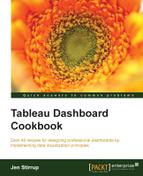Tableau Dashboard Cookbook is an introduction to the theory and practice of delivering dashboards using Tableau. The recipes take you through a step-by-step process of creating the building blocks of a dashboard and then proceed towards the design and principles of putting the dashboard items together. This book also covers certain features of Tableau, such as calculations, which are used to drive the dashboard in order to make it relevant to the business user. The book will also teach you how to use key advanced string functions to play with data and images. Finally, this book will help you consider what to do next with your dashboard, whether it's on a server or in collaboration with other tools.
Chapter 1, A Short Dash to Dashboarding!, introduces you to the Tableau interface while ensuring that you are producing dashboards quickly.
Chapter 2, Summarizing Your Data for Dashboards, teaches you how to summarize data as a way of conveying key messages on your dashboards for top-down analysis. It also introduces you to calculations with a particular focus on using dates for analysis and comparison.
Chapter 3, Interacting with Data for Dashboards, guides you through to the next stage after summarizing your data, interacting with your data, and providing more details where appropriate to enhance the story on the dashboard.
Chapter 4, Using Dashboards to Get Results, presents ways to make your dashboards actionable for the dashboard viewer. We will look at a guided analysis in Tableau as a way of facilitating a structured investigation of data. We will also research the ways of enhancing your data via mashups and external data sources, all in your dashboard.
Chapter 5, Putting the Dash into Dashboards, focuses on graphically presenting the data with Tableau dashboards in mind. We will look at sparklines, KPIs, small multiples, and maps, to name a few.
Chapter 6, Making Dashboards Relevant, guides you through the ways in which you can make the dashboards relevant to your organization. We will look at theming and adding more details to the dashboard.
Chapter 7, Visual Best Practices, provides examples of the more advanced features of Tableau, such as calculations. The recipe exercises are underpinned by an explanation of the visual best practices as we proceed through the chapter.
Chapter 8, Tell the World! Share Your Dashboards, shows different ways to share your dashboards with different audiences, both inside and outside your organization.
